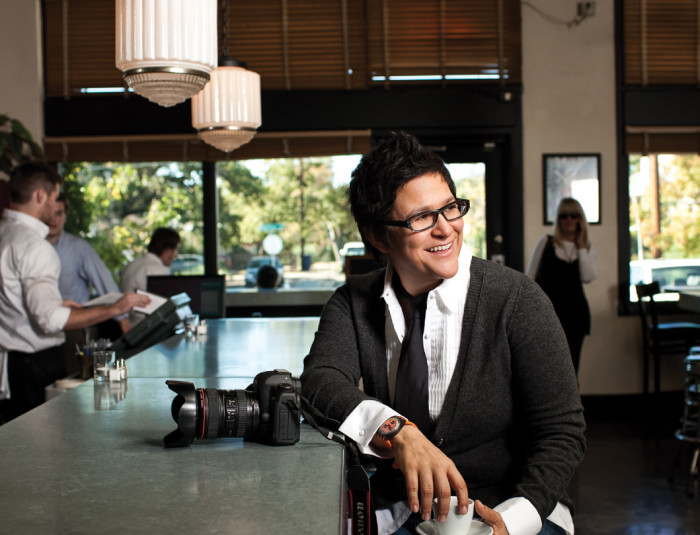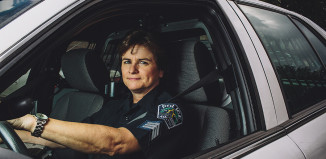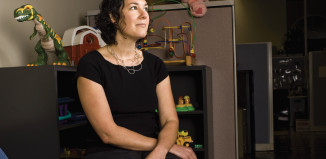The modest apartment in Beirut, Lebanon, is pitch black, save for the golden hue emitted by the candles scattered on the floor over the drop cloth, made of plastic garbage bags. The scent of turmeric, nutmeg, and cinnamon waft through the air. The power has gone out in the area and it’s late. Hezbollah watchmen on rooftops patrol for any signs of suspicious activity, so photographing them with a flash is out of the question. The six Iraqi men, all in their twenties, are refugees and second-class citizens in this foreign land. They bring out a feast they’ve spent all day preparing together: plates of Iraqi-style beef and vegetable stew, known as kabset baitenjan, plenty of rice and flat bread, and spiced chicken and chickpea stew, called tashreeb dijaaj. In the middle of all this, Penny De Los Santos–a woman, a Westerner and a journalist–is capturing this amazing moment of community and cultural bonding under the most stressful circumstances.
“Being with those men took my heart away,” she said. “Because of my camera and because of food, I was able to sit with them and have this amazing experience. That was one of the most powerful and enlightening tables I’ve ever sat at.”
De Los Santos, who has traveled to 30 countries in her relatively young career as a photographer, had to tread carefully throughout that assignment for National Geographic, walking several feet behind the Iraqi men at the food market, never speaking English around them (her fixer, or guide, acted as a translator) and showing utter discretion. It was for her personal safety, as well as the safety of her subjects. Whether in a marketplace in Jerusalem or in a women’s prison along the Mexican border, De Los Santos is at home as a photographer amidst the chaos of everyday life.
“The great thing about what I do is it’s real people in real places,” she said. “It’s not always a fancy five-star chef.” A self-confessed foodie, award-winning photographer, blogger and general globetrotter, De Los Santos never considered photography as a career early on, although she took her first picture at the age of 10.
The daughter of a military man who was stationed at Fort Hood, the family traveled a lot when she was young, taking frequent trips to the South Texas border towns near Mexico, or crossing the border to shop and revel in their cultural heritage. On one such trip, en route to a restaurant serving delicious cabrito, or baby goat, De Los Santos saw a young girl sitting on the street.
“I was really taken by how she looked and her– the emotion she conveyed in her face–it was instinctual for me to react to who she was,” said De Los Santos, noting that the girl, who was sitting with her mother, might have been homeless. “I made a portrait of her. My dad has that picture on his fridge.”
 Ultimately, this modest young woman, who studied journalism and marketing as an undergraduate at Texas A&M University and received her master’s in visual communications at the University of Ohio, believes in the power of telling stories through visuals.
Ultimately, this modest young woman, who studied journalism and marketing as an undergraduate at Texas A&M University and received her master’s in visual communications at the University of Ohio, believes in the power of telling stories through visuals.
“It’s a great challenge, to do that with a still photograph, to take a moment and think about light, think about color, think about composition–and think about that person–and then try to capture it in a thirtieth of a second. It’s a huge challenge and it takes a lifetime to master. It’s an amazing creative journey and that’s what I love about it. Are you ever perfect at it? No, but you’re always growing and learning.”
Over the course of three conversations, all of which involved some type of culinary delight, De Los Santos was serious, goofy, inquisitive and always intense, displaying all of the characteristics that make her such a successful photographer.
Swim for the Shore
Even though De Los Santos had been taking pictures and was involved with the yearbook in college, it wasn’t until she landed a coveted and highly competitive internship at National Geographic, based solely on her submitted portfolio, that she launched her career.
Photography has always been the lens through which De Los Santos increased her cultural bona fides. As a Mexican-American woman, she’s curious about the transformation happening along the border and the ways in which crime, immigration and politics play out in the region. Her documentary project, on women and children in prison, allowed her unprecedented access to the Penal II prison in Nuevo Laredo, Mexico.
The town, a focal point for a lot of the drug violence happening in that part of Mexico, housed a prison where women who are serving time could keep their children with them in prison. After scraping together enough money to spend some time there, De Los Santos ended up staying for a week and used that body of work to apply for the internship.
National Geographic, known for its distinctive yellow border and gorgeous, often breathtaking imagery, has a baptism-by-fire philosophy regarding new photographers. In 1998, De Los Santos knew it was the opportunity of a lifetime, representing a chance to see the world, work with some of the most talented photographers in the industry and create a body of work that would open other doors for her.
The magazine’s director of photography handed her an envelope containing her first assignment, in France. She had a translator, some money, the story outline and a cell phone. She only spoke to her editor once while she was there. Although she described it as the “scariest time,” De Los Santos excitedly jumped straight into the frenzy of the situation–photographing a festival–and that was the beginning of a ten-year relationship with National Geographic. Through a connection her colleague had, De Los Santos began a professional relationship with Saveur, a publication that’s often called the National Geographic of food–for its union of food and culture around the world.
“My editor said, ‘I want you to go into these assignments with the same sense as you would at National Geographic. It’s about people and culture,’” said De Los Santos. “That was the beginning of my epiphany. Photographing food and seeing life and culture as it happens through food is just amazing.”
One of the reasons she became a photographer was to document, and learn about, the culture of the shanty-towns along the Mexican border. Her family is from there, but since De Los Santos mainly spent weekends visiting, she didn’t get to connect with her heritage as much as she would’ve preferred. A $50,000 grant from National Geographic for a photographic essay changed all that.
“I discovered who I was. I didn’t grow up around a Hispanic or Latin community at all and I didn’t identify with it,” said De Los Santos. “My Spanish was average, my accent sucked. I always felt a little awkward.”
For four years (stretching the grant as far as possible), she photographed everything she could. In 2006, the photographic essay was published in print (and online) in National Geographic. It’s a project dear to her heart and one that she’ll always return to, perhaps making it into a book down the line.
The landscape of that part of the country is constantly changing in dramatic ways. In 20 years, it will be completely different. She credited National Geographic for believing in her project and backing it with a significant financial investment.
Eagle Eyes
De Los Santos is constantly observing everything around her. Whether that comes from having moved a lot as a child or if it’s innate to her personality, very little escapes her watchful eye. As a photographer, it’s what makes her tick. She has to intuitively feel the perfect moments, sense when they’re about to happen and then capture them within seconds.
Growing up Latina, De Los Santos early on recognized the importance of food as a point of community-building amd comfort. “I think cooking and food, because I’m Mexican-American, it’s in my DNA,” she said. “There are always celebrations around it and it’s a positive experience.” However, she didn’t see how taking pictures could be a lifelong career. “If anyone had told me this, I would have been like, ‘you’re crazy,’ she said. “It was about this camera, this black box that I fell in love with.”
Both of her parents, born and raised in Laredo, Texas, were hard workers, and she credited them with inspiring her own work ethic. De Los Santos has one brother who works as an electrical engineer for NASA in Houston.
At the time, De Los Santos didn’t realize that she had grown up in such a conservative environment; she attended high school in Killeen. Although she always sensed she was different, and dressed a little funkier than her peers, the revelation of her sexuality came between undergraduate and graduate school when she met a good friend’s older sister who happened to be a lesbian. “I just latched onto her,” said De Los Santos, smiling at the memory. “It was like, wait a minute, you’re gay. There’s all this pressure to date or be with someone or be sexual with someone, but I just never accepted that.”

Her late-blooming sexuality is a testament to how career-driven she was in those early days. To the detriment of her social life, De Los Santos pursued photography with a singular enthusiasm and vigor that pushed other concerns aside. “Photography was my first love,” she added. “And it’s held my attention and interest.”
Creative inspiration
That love of photography is what brought her and Christina Gomez-Mira together about five years ago. Gomez-Mira met a National Geographic wildlife photographer in Panama through a friend. After having worked in the Peace Corps and photographing the scenes of devastation in post-Katrina New Orleans, Gomez-Mira was ready to take the plunge into professional photography. After working together for eight months, the photographer suggested Gomez-Mira meet his friend, De Los Santos.
Although they didn’t connect immediately after having coffee the first time, an opportunity to work together on a story later sealed the deal.
De Los Santos was going to be up in a helicopter taking pictures and needed a Spanish-speaking coordinator on the ground who could essentially be her assistant. She called Gomez-Mira, invited her and they had a blast. Still, initially it was a friendship-based connection. “We were total goofballs, and it slowly developed after that.”
Gomez-Mira, now in her second year of medical school at the University of Texas Medical Branch in Galveston, worked for three years as a health educator for People’s Community Clinic in Austin, where she managed the group’s satellite clinic for homeless youth. That sparked her interest in community health and, in particular, working with underserved populations.
They’re looking forward to being back in Austin full-time in May, which is when Gomez-Mira starts her rotations. Meanwhile, they love traveling together, exploring other culinary cultures and cooking fabulous feasts for their friends. Last summer, the couple went to Mali. De Los Santos had an assignment in nearby Senegal, and they returned to the village of Manega, a rural outpost in Burkina Faso where Gomez-Mira had worked for two years as a Peace Corps volunteer ten years earlier. “It was really amazing to be able to have her there and share that with her,” said Gomez-Mira. “We’re both really independent and supportive of each other’s work.”
The trip afforded them several opportunities to soak up the West- African food culture and learn about cooking techniques and local traditions from residents and at street markets. One of the first things we made togeth- er was this amazing local juice from a yellow fruit called “zaaba” that my friend taught me to prepare,” recalled Gomez-Mira. “We also made another juice called beesap, made from hibiscus and mint.”
“I fell in love with Christina for many reasons, but the biggest reason is her heart. She’s got an incredible heart, and she’s a true humanitarian,” said De Los Santos.
Other than traveling together, this busy couple connects in typically Austin ways. De Los Santos loves to swim at Deep Eddy or Barton Springs and cook meals with her girlfriend. Trips to all of the culinary storefronts that Austin has for its food-obsessive residents are therapeutic for her. It’s less about the lavishness of the meal and much more about staying connected to friends and breaking bread with loved ones.
Anticipating Perfection
Whether it’s a barely perceptible shift in light, the way in which the corner of someone’s mouth briefly turns, or a feeling that something special is happening, a De Los Santos photograph captures the subtle, extraordinary- in-the-everyday moments. Oftentimes, it’s the feeling the moment is going to give you, being completely in tune with that, which involves a lot of careful listening and observation.
“People understand pretty quickly that I’m there for them,” she said. “It makes them feel special to know that I care about them enough to want to do this work and want to tell their story.”
De Los Santos has been invited to be a guest speaker at the International Association of Culinary Professionals conference, a large event that draws thousands from across the globe, which is being held in Austin in June. At a different conference, where networking was part of the experience, De Los Santos met Kirsty Melville, a publisher with Andrews McNeel Book Publishing.
The two met at the International Food Blogger Conference last year, where De Los Santos was a captivating presenter and speaker. “She was inspirational not only through her work and her dedication to continu- ous learning, but through her example of living authenti- cally and bringing her whole self to everything she does,” said Melville. “While Penny takes her work very seriously, she never takes herself too seriously. Just when everyone is getting all teary-eyed, you can count on Penny to tell a good joke.”
Overall, her career has made her a more sensitive, intuitive listener and more accepting of different opinions, she said, including people who may have been uncomfort- able with her sexuality. “My job is to just be a hundred percent accepting of them.”
De Los Santos offered key pieces of advice for aspiring photographers: First, it’s all about the person on the other side of the camera, and not the one behind it. The second is that it’s about accessing your own truth and using that as a way to fully bear witness to someone else’s truth.
“It’s about being in touch with who you are one hundred percent. You should operate from that space,” she said. “I think the most intuitive, sensitive, meaningful photographs happen when you’re there.”
A myriad of factors make a perfect photograph, be it the sounds and smells, the facial expressions of participants, or the topics of conversation at the table. De Los Santos believes that is why many photographers are also foodies, because they’re utilizing and reacting to the same senses as the food-obsessed. As she noted throughout, food is the great connector and equalizer.
Whether De Los Santos ends up with her own book, turns her work along the border into something bigger or simply continues to take lovely photos for Saveur and other publications, she understands that her work and her life as an openly gay photographer is part of a much bigger ongoing societal shift.
“It broke my heart hearing about all those young people,” she said, referencing the media’s coverage of LGBT teen suicides in the fall. “It’s important for people to see that you can have a career and dream a good dream and have it happen and be gay. The world isn’t limited if you’re gay. We need to stand up tall and proud.”




































